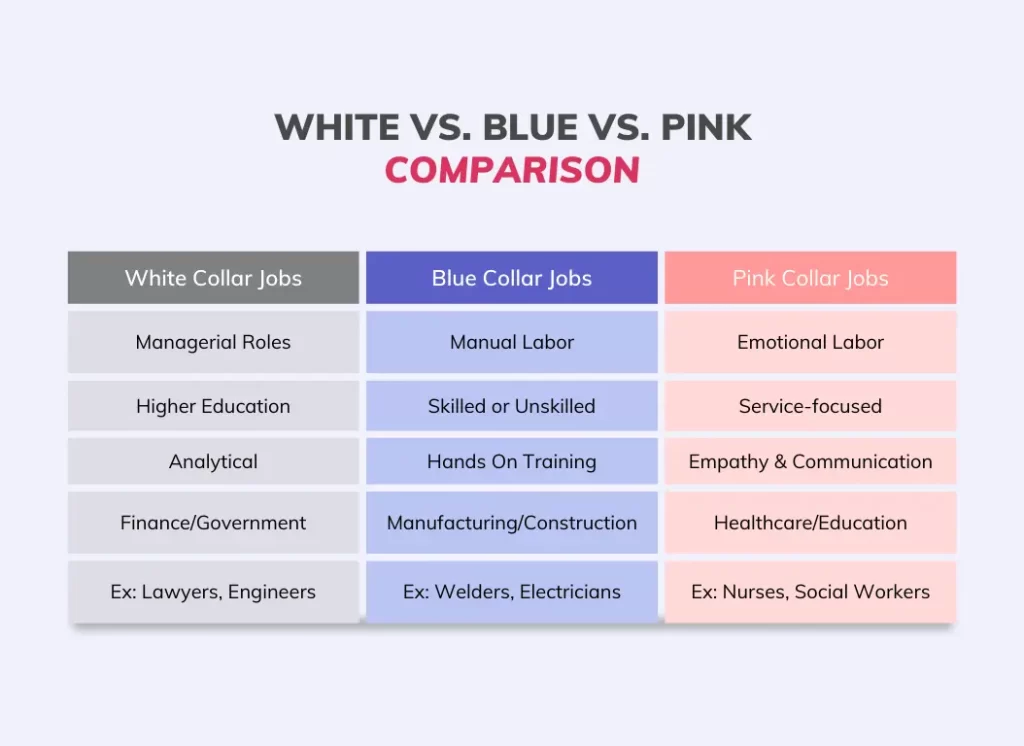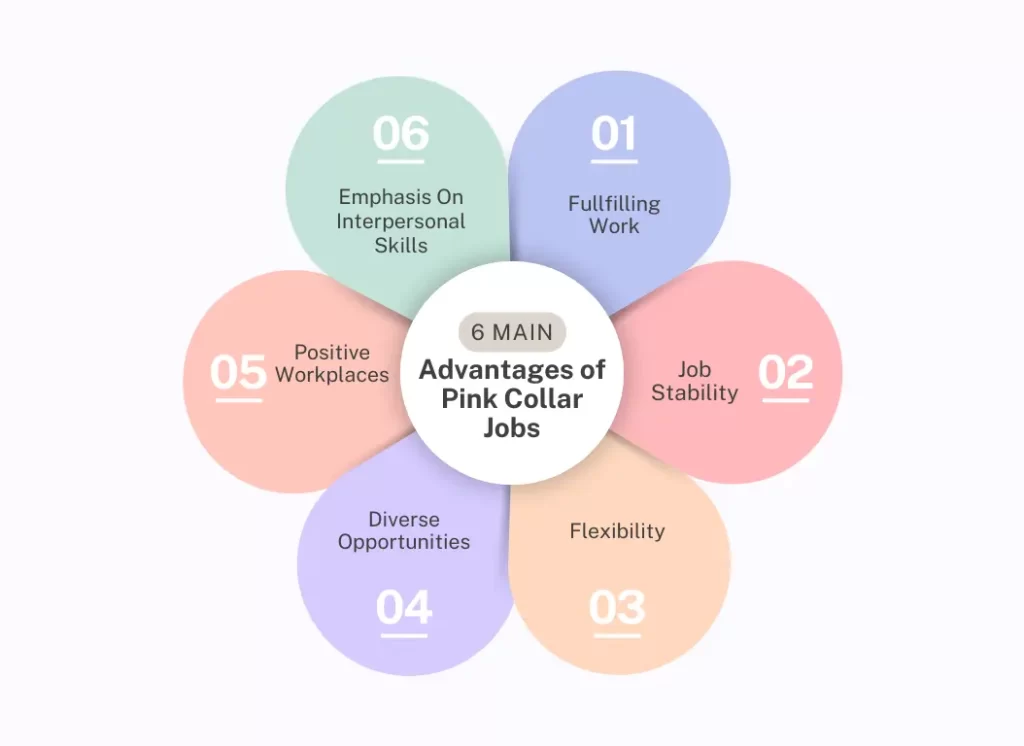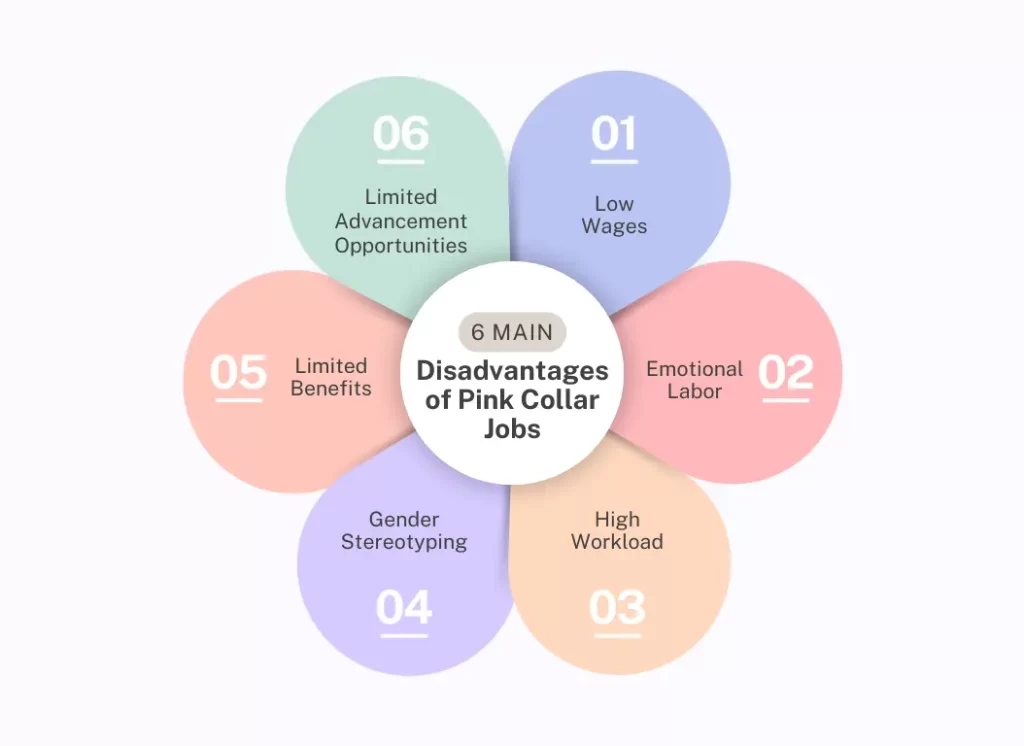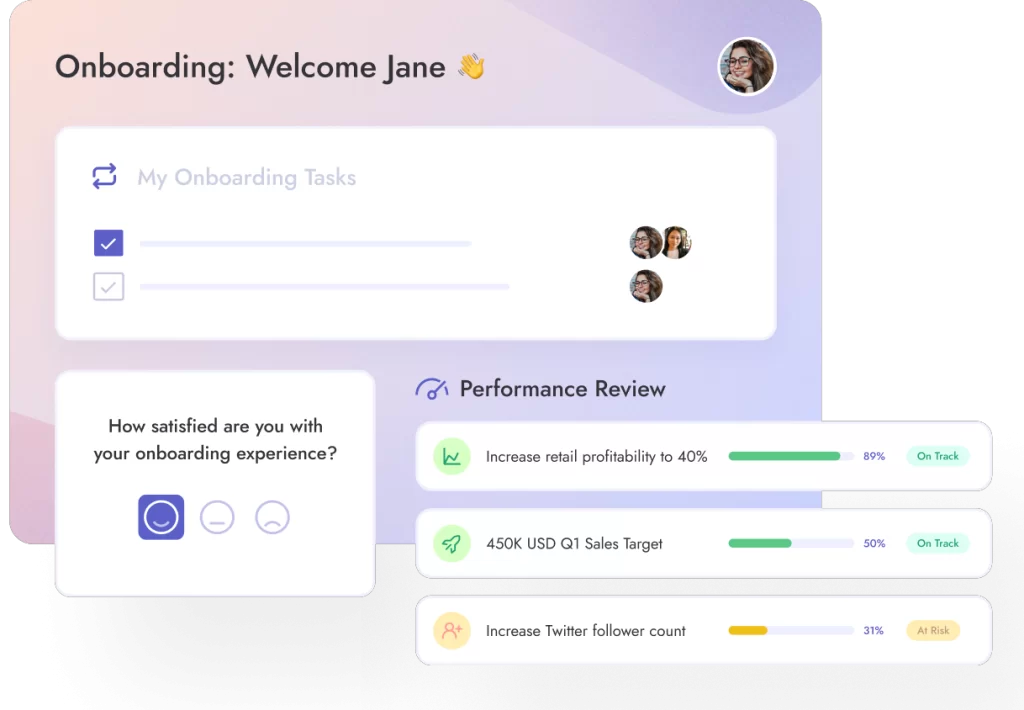Traditional job roles are currently undergoing a major transformation in our modern world. Among the many changes happening, one particular term has become extremely popular, and that is pink collar jobs. But why is it so common?
Thus far, our understanding of job roles has been all about white or blue collar jobs. The blue was associated with manual labor jobs while white collar were more about roles that were administrative or managerial positions. However, right in the middle now there is pink collar jobs, a category that holds diverse opportunities.
Let’s take a closer look into what pink collar jobs are, understand what defines them, why they are important, some examples, and more! Whether you’re a job seeker, or a seasoned professional, having a deeper insight into pink collar jobs will give you a fresh perspective.
Table of Contents
What Are Pink Collar Jobs?
Pink collar jobs represent roles in our world that are traditionally held by women and are often associated with roles that specify in industries like healthcare, education, retail, or hospitality. Mainly in areas where caretaking comes into play in one shape or the other, these are positions that are believed to be coming more naturally to the women of our societies.
Some characteristics of pink collar jobs are lower wages, yet roles that require interpersonal skills, empathy, and emotional labor. While these positions are not necessarily limited to women, they are highly linked to women in our society. Most notably, pink collar jobs have been professions that are highly undervalued regardless of the effort they require.
The History Of Pink Collar Jobs
Pink collar jobs may be a newer term, but the history of what it represents is not so new. Let’s take a look at a brief historical overview of what the term “pink collar jobs” means.
- World War II: During the Second World War, with many of the men serving, women had to take part in different roles in society. This was a serious shift in where women were a part of as now they were suddenly working in factories, shipyards, and other traditionally male-dominated spaces.
- Post-War Period: When the war ended, while there was pressure for women to return to the norms previously established, many women had also already found independence in other roles outside of the home. These were occupations in healthcare, education, retail, and others.
- Gendered Labor: The “pink collar” term was coined in the 1970s to describe the growing number of positions in service-oriented industries that were women-leading. These jobs were noticeably linked to nurturing roles that were deemed suitable for women and their womanly nature.
- The Feminist Movement: The Feminist Movement arising in the ’60s and ’70s brought a lot of attention to gender discrimination and inequalities in the workplace. Women began to advocate for equal pay, access to higher-ranking positions, and accurate recognition. While there was progress, pink collar jobs were still undervalued and still were filled with predominantly women.
- Contemporary Trends: In more recent years, pink collar jobs have had some growth due to certain reasons such as population aging and increased demand for industries like education and healthcare. However, wage gap issues and challenges in representation in leadership positions are still inequalities that are being faced daily.
White vs. Blue vs. Pink

White Collar Jobs
White collar jobs are typically known to be positions of professional, managerial, or administrative roles. These occupations require higher education, specific skills, and analytical thinking traditionally. The work is often in an office and tasks require decision-making and problem-solving skills.
To give some examples, white collar jobs include, lawyers, doctors, engineers, accountants, executives and managers.
Blue Collar Jobs
Blue color jobs are often roles that require manual labor and a type of skilled or unskilled work that is in an industry such as manufacturing, construction, or trade-related sectors. The skills would likely include hands-on training, physical labor, operating machinery, or repairs.
Some examples of blue collar jobs are; welders, electricians, carpenters, construction workers, mechanics, factory workers.
Pink Collar Jobs
As we’ve mentioned, pink collar jobs are service-focused occupations that are traditionally held by women simply because the position involves some form of caregiving. Typically in industries of healthcare, education, retail, or hospitality, these occupations are often associated with qualities like empathy, communication, and attention to detail.
To provide some examples of pink collar jobs; nurses, teachers, service representatives, administrative assistants, and hospitality staff are considered pink collar jobs.
Examples Of Pink Collar Jobs
To get a sense of what the pink collar jobs are in our society, let’s take a look at some examples.
- Nursing: Nurses provide direct care in various healthcare settings such as hospitals, clinics, and nursing homes. They assess the needs of patients, administer medication, monitor vital signs, and collaborate with other professionals to ensure optimal patient outcomes.
- Teaching: Teachers work in different levels of education settings, instructing, educating, and looking after children of different age groups. They develop lesson plans, assess students’ progress, provide academic support, and create a positive learning environment to ensure their students’ success.
- Customer Service Representative: Customer service representatives are regularly in touch with customers to address their inquiries on various accounts, provide solutions for different issues, resolve complaints, and provide assistance on products or services in their day-to-day. They may communicate via phone, email, or online chat platforms, and their main focus is delivering excellent customer experiences.
- Administrative Assistant: Administrative assistants provide support to organizations on several levels, including scheduling appointments, managing correspondence, maintaining documents, and coordinating office activities. Administrative assistants often serve as the first point of contact for clients, visitors, and employees, and need to provide excellent hospitality.
- Retail Sales Associate: Retail sales associates work in stores or online platforms, and they are the ones who assist customers with product selection, answering questions, processing transactions, and maintaining store displays. Their duty is to create a positive shopping experience for customers and meet sales goals.
- Receptionist: Receptionists greet visitors, answer phone calls, and manage inquiries in various settings, such as offices, medical facilities, hotels, spas, and more. They also often perform other administrative tasks like scheduling appointments, coordinating meetings, and managing office supplies.
- Home Health Support: Home health aides assist their clients with activities of daily living, such as bathing, dressing, grooming, and meal preparation. They can also provide companionship and housekeeping services to clients who are elderly, disabled, or recovering from illness or surgery.
What Are The Advantages And Disadvantages Of Pink Collar Jobs?

Advantages
- Fulfilling Work: Many pink collar positions involve assisting others, whether it’s providing healthcare, education, customer service, or administrative support. The sense of purpose and fulfillment behind these roles can be personally rewarding and contribute to higher job satisfaction and employee experience.
- Job Stability: Pink collar jobs tend to be in industries that are less susceptible to economic downturns. Healthcare, education, and certain service sectors are likely to remain relatively stable regardless of the overall economic uncertainty in the world. This provides greater job security for people who are in these roles.
- Flexibility: Some pink collar jobs are able to offer more flexibility in terms of work schedules and locations. For example, nurses may have options for different shifts or work arrangements, while administrative assistants can have opportunities for remote work or flexible hours.
- Diverse Opportunities: Pink collar jobs include a wide range of occupations that range into various industries. This provides diverse career options and career paths for professional growth. In this sense, with pink collared jobs, there are many to pursue meaningful and fulfilling careers.
- Positive Work Environments: Pink collar jobs tend to include a supportive workspace due to the empathy-filled nature of the positions where there is frequent interaction of people with individuals who share similar values. This provides a sense of camaraderie and teamwork will inevitably contribute to a positive workspace and cultivate meaningful professional relationships.
- Emphasis on Interpersonal Skills: Pink collar jobs are ones that require strong interpersonal and communication skills, which are essential in both professional and personal senses. With these skills put to use, enhanced relationships will help create a positive workplace and enhance professional relationships.

Disadvantages
- Lower Pay: One of the biggest issues of pink collar jobs is the fact that they are often positions with lower wages. Despite the importance and highly demanding nature of these roles, they tend to be undervalued and not recognized fairly.
- Limited Advancement Opportunities: Even though some pink collar jobs offer pathways for career growth, other roles might not have the same opportunities for upward mobility. This can occur cause of factors such as industry constraints, and lack of educational resources.
- Emotional Labor: Most pink collar jobs come with significant emotional labor, requiring workers to manage their emotions and provide support and empathy to others, all for lower wages too. Dealing with stress, compassion fatigue, and burnout can take a toll on people in pink collar jobs who work to give care to others, whilst being unrecognized.
- High Workload: Pink collar jobs, especially in industries such as healthcare and education, are typically heavy in workload and involve long hours with a side of demanding schedules. The pressure to meet deadlines and rise to every occasion and reach performance targets all at the same time can contribute profoundly to stress and job dissatisfaction.
- Gender Stereotyping: Pink collar jobs are heavily associated with women and femininity, resulting in gender stereotypes and bias in the workplace. Men who work in such positions also tend to face stigma or discrimination based on society’s expectations of gender roles and career positioning.
- Limited Benefits: In certain examples, people who work in pink collar roles may receive fewer benefits compared to others, like healthcare coverage, retirement plans, or paid leave. This gap in benefits can contribute to financial issues and job insecurity for people.
What Is The She-Cession?
The She-Cession is a term that came to be known during the COVID-19 pandemic and refers to the disproportionate effect of the pandemic on women during the recession and the overall economic toll COVID-19 took on the world globally.
Soon after the pandemic hit it became quite clear that sectors with more women in them like hospitality, retail, and education were hit the hardest by the lockdown and other consequences of the crisis. Women from marginalized communities especially, faced many challenges such as losing their jobs, having reduced hours, and yet increased caregiving responsibilities nonetheless.
The result was the term She-Cession, which highlights the gendered nature of the economic disturbances and the need for initiatives that will address the specific vulnerabilities of women in the workforce. According to Ahona Halder’s research, the effect of COVID-19 on women’s employment in percentages was significantly more severe with a decline of 39% for women and only 29% for men. Even though it is only one example, Halder’s research perfectly highlights why the term came to be.
Men In Pink Collar Jobs
In recent years, however, things have not all been bad. There has been a shift in who chooses to partake in pink collar jobs and it’s not only women. The men who do prefer these occupations is on the rise and they are challenging traditional gender stereotypes.
According to Alexia Delfino’s research, more than 70% of social workers in the US and in the UK are historically women. However, she goes on to explain how perceived gender doesn’t quite affect men and the policies that encourage men to not only apply but also improves the quality of the applications.
One important part of why more men are finding pink collar jobs is the changing market. As there are more and more technological advancements many male-dominated industries are experiencing stagnation and job losses. On the other hand, industries like healthcare, education, and social services commonly associated with femininity are growing rapidly.
Thankfully, the way society views gender and the societal norms we’ve been following are also in transformation. More and more people are no longer interested in nor abiding by the rules of outdated traditions and there is more room for diversity and equality now.
Best Practices For Hiring
To ensure the creation of a diverse workplace, we believe all organizations can benefit from the following best practices!
- A Diverse Hiring Team: Ensuring that the team in charge of creating your workforce is diverse is bound to give you the wide range of perspectives that are required to create an inclusive workforce. They will be able to help you mitigate any unconscious biases and promote a fairer process overall.
- Inclusive Job Descriptions: The language we speak is often more important than we realize. Using inclusive language in your job adverts is a great way to attract all kinds of top talent. This way, the focus is actually on the quality of your candidates and not any gendered or otherwise biases.
- Diversity Training and Statement: Embodying a diverse outlook as an organization will transcend just a diverse hiring team and inclusive job adverts. The work will continue as your workforce operates. Provide them with the necessary training to promote the same level of inclusivity you’re searching for and show your commitment as an entity by having a diversity statement in place.
- Standardized Interview Processes: Develop a set structure for your interviews so that you can ensure a fair process for all of your candidates. This will help minimize any biased influences and keep the evaluations’ focus on their abilities and qualifications.
And what better way to do that than to make use of the best technology out there! Teamflect is an all-in-one performance management solution inside Microsoft Teams that will help you in all your hiring processes.

Not only does Teamflect offer seamless integration with the Microsoft landscape, but it also provides users with;
- Streamlined hiring and performance review processes.
- Ability to track goals / OKRs inside 1:1 meetings to ensure goal alignment.
- Gaining and sharing key insights to develop and engage your team with 360-degree feedback.
- Customizable recognition badges to reflect your company values and so much more!
With Teamflect’s help, you can create a much more inclusive and diverse organization, curated by us and customized by you in alignment with your specific needs. Try Teamflect today to start your digitized, structured, and inclusive hiring process!



